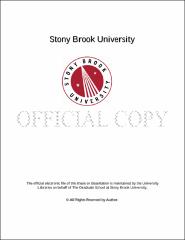| dc.identifier.uri | http://hdl.handle.net/11401/76958 | |
| dc.description.sponsorship | This work is sponsored by the Stony Brook University Graduate School in compliance with the requirements for completion of degree. | en_US |
| dc.format | Monograph | |
| dc.format.medium | Electronic Resource | en_US |
| dc.language.iso | en_US | |
| dc.publisher | The Graduate School, Stony Brook University: Stony Brook, NY. | |
| dc.type | Dissertation | |
| dcterms.abstract | Our interests are in using structure based drug design to target bacterial agents and toxins that have the potential for intentional release into the environment and therefore pose a severe threat to public health and safety. Specifically, we focus on the pathogenic bacteria Francisella tularensis and Yersinia pestis, as well as the Clostridium botulinum neurotoxins (BoNTs). Our strategy for F. tularensis and Y. pestis was to target the bacterial system for fatty acid biosynthesis (FAS-II). The FAS-II system contains several enzymes whose sequence and structure is highly conserved across a vast array of pathogens. This coupled with the low homology to the equivalent system in humans makes this pathway an excellent target for antimicrobial drug development in general, as well as the development of broad-spectrum antibiotics. To this end, we have cloned, expressed, and purified the FAS-II enzyme, ï ¢-hydroxyacyl-Acyl Carrier Protein Dehydratase (FabZ), from both F. tularensis (FtFabZ) and Y. pestis (YpFabZ). We also performed an enzymatic characterization of both proteins as well as several mutant forms of YpFabZ in order to elucidate the structural features important for substrate and inhibitor binding. Additionally, we have discovered two novel compounds, Mangostin and Stictic Acid, which demonstrate potent inhibition of both YpFabZ and FtFabZ. The scaffolds of these two compounds represent excellent starting points for further design of broad-spectrum antimicrobial drugs. The BoNTs are zinc metalloproteases that cleave and inactivate proteins critical for neurotransmission. There are seven serotypes of the BoNTs, several of which are toxic to humans. In order to adequately screen potential drugs targeting the BoNTs we developed a novel fluorescence assay that utilizes a recombinant GFP-bound substrate and is capable of detecting enzymatic cleavage by all seven BoNT serotypes. Using this new assay, in conjunction with a virtual screen of 1.4 million potential inhibitor compounds, we discovered a novel inhibitor of BoNT serotype E. | |
| dcterms.available | 2017-09-20T16:51:32Z | |
| dcterms.contributor | Swaminathan, Subramanyam | en_US |
| dcterms.contributor | Tonge, Peter | en_US |
| dcterms.contributor | Rizzo, Robert | en_US |
| dcterms.contributor | Studier, William. | en_US |
| dcterms.creator | McGillick, Brian Edward | |
| dcterms.dateAccepted | 2017-09-20T16:51:32Z | |
| dcterms.dateSubmitted | 2017-09-20T16:51:32Z | |
| dcterms.description | Department of Biochemistry and Structural Biology. | en_US |
| dcterms.extent | 126 pg. | en_US |
| dcterms.format | Monograph | |
| dcterms.format | Application/PDF | en_US |
| dcterms.identifier | http://hdl.handle.net/11401/76958 | |
| dcterms.issued | 2015-12-01 | |
| dcterms.language | en_US | |
| dcterms.provenance | Made available in DSpace on 2017-09-20T16:51:32Z (GMT). No. of bitstreams: 1
McGillick_grad.sunysb_0771E_12494.pdf: 4426568 bytes, checksum: 530ef9130b670b122628838c04b248ab (MD5)
Previous issue date: 1 | en |
| dcterms.publisher | The Graduate School, Stony Brook University: Stony Brook, NY. | |
| dcterms.subject | Biochemistry | |
| dcterms.subject | Assay Development, Boutulinum Neurotoxins, FabZ, β-hydroxyacyl-ACP dehydratase | |
| dcterms.subject | Assay Development, Boutulinum Neurotoxins, FabZ, β-hydroxyacyl-ACP dehydratase | |
| dcterms.title | Structure Determination, Enzymatic Characterization, and Inhibitor Discovery of Select Protein Targets of Bacterial Pathogens | |
| dcterms.type | Dissertation | |

